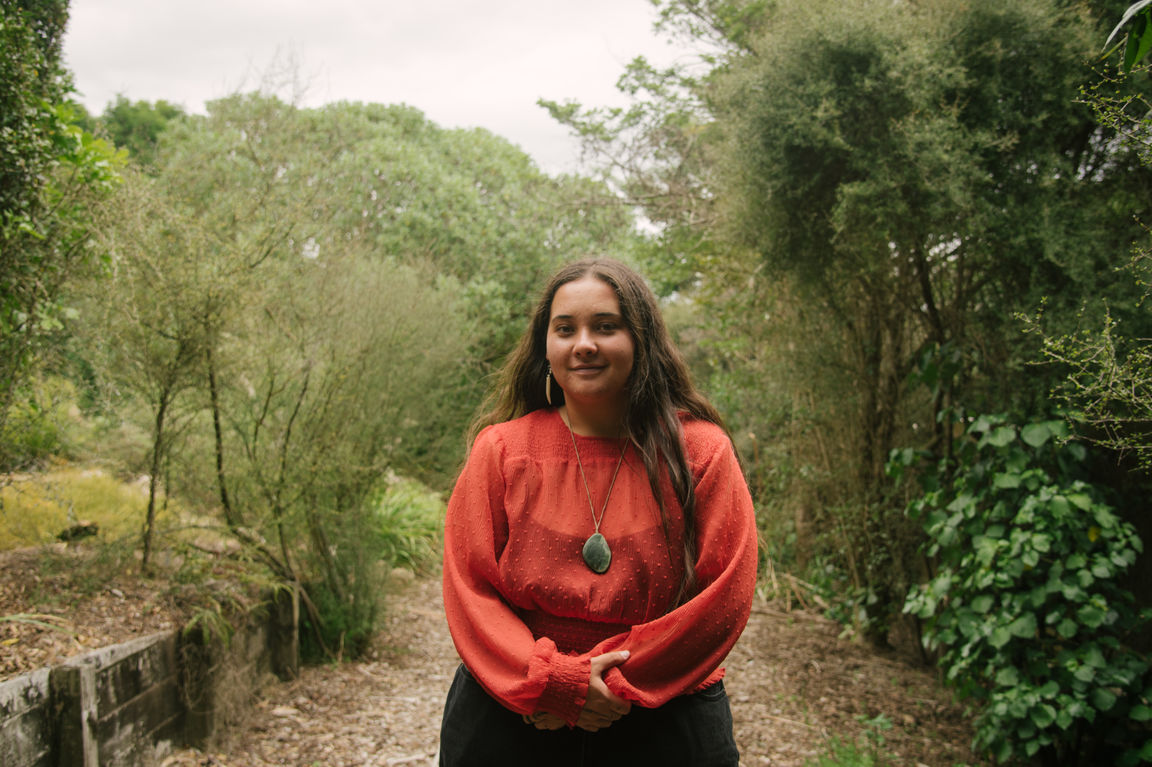May we boundlessly dream of possibilities beyond our wildest imaginations. May we weave communities of support, compassion and active solidarity. With our history in front of us, and our tūpuna at our shoulders, may we walk into a future that is connected and thriving for us all. This is He Kākano Ahau Season 2: Wawatatia.
In episode two, we meet three people working in different ways to revive and reclaim mātauranga Māori within a modern context.
Scroll down to the bottom of the page to listen to the podcast.

Kahu, Sarah and Lanae at Te Ahiaua Photo: UGP / Te Aho Jordan
Reclamation
Words by Briar Pomana
Taonga tuku iho is an intrinsically Māori approach to life and whakapapa, a process in which through a multitude of mediums can both empower and heal. As Māori, we stand on the shoulders of our tīpuna and carry their knowledge forward.
Episode two of He Kākano Ahau: Wawatatia looks deeper into practices and taonga that may have been left behind in our histories. It engages and opens wānanga with artists, activists and communities that every day, are unlocking parts of themselves that have previously been shunned from the light as a direct result of colonisation.

Sarah Hudson and Lanae Cable Photo: UGP / Te Aho Jordan
Host Kahu Kutia takes listeners deep into the ancestral land of Mātaatua waka with friends Lanae Cable and Sarah Hudson, two of three artists who make up the decolonial research collective Kauae Raro, and then further down the country to Te Whanganui-a-Tara to meet Jayden Rurawhe, an uri of Te Rarawa iwi and co-director of the show He Tangata.
Kauae Raro is nothing short of magical. On their Instagram, images of earthy tones and pigments in various jars and mixtures are a feast for the eyes. It is with these traditional whenua-derived colours that researchers and artivists Lanae Cable, Sarah Hudson and Jordan Davey-Emms are relearning, returning and creating with the materials of their tīpuna, directly from the taiao.

Scraping orange clay with Kauae Raro Photo: UGP / Te Aho Jordan
The pigment kokowai, found in clay or rocks, comes in a variety of shades most often tinged red-brown. For some, the pūrākau of Hineahuone and Tāne comes to mind. This narrative may then lead to ideas around beginnings, birth, deepness and space, conceivably thoughts of life, land, and love. Kokowai for others is simply hardened mud and rock.
All of these ideas, say the collective, were shared by the people walking these lands centuries ago.
"It was used by our tūpuna as art-making material, in ceremony, to rongoa. Sunblock to keep sandflies off. For painting. There were also beautiful practices of adornment, like makeup - painted cheeks, foreheads, lips, bodies, whole bodies. Sometimes you can see kapa haka roopu have a red, sometimes that's kokowai."

Kahu Kutia interviewing Kauae Raro Photo: UGP / Te Aho Jordan
Communities such as Kauae Raro are working to reconnect with the land and with each other. Walking and touching together they are animations of their ancestors in the purest forms and this reclamation is happening everywhere in Aotearoa.
Kahu explores this journey with Jayden Rurawhe as their theatre show He Tangata ushers in Wellington Pride.
"I hadn't seen myself represented in a way that I would like to see myself. I didn't see Takatāpui ever. There were no stories about me, there were no stories about us. And I felt that was a necessary thing that had to be showcased."
The show, choreographed and co-directed with Paris Elwood, is a love letter to the Takatāpui community.
"I wanted Takatāpui to come home within themselves," says Rurawhe.

Sarah at Te Ahiaua Photo: UGP / Te Aho Jordan
Kahu speaks further with Rurawhe about how exhausting decolonial work can be. Lanae Cable, Sarah Hudson and Jordan Davey-Emms of Kauae Raro know this depleting feeling of constantly being on the frontlines of the kaupapa. And according to Kauae Raro, there is a clear purpose,
"It's that simple, land back, give us our land back… And when we talk about land back, we're talking about water back, we're talking about ceremonies back, we're talking about our sexualities back, our bodies back."
From these conversations with Kauae Raro and Jayden Rurawhe, it is clear that a Māori renaissance is amongst us, people and artists are working hard every day for a future that will see their mokopuna thriving proudly on their own lands, in their own bodies, gloriously themselves and unapologetically Māori.
Episode two of He Kākano Ahau: Wawatatia is about taonga tuku iho, land back and the sexiness of native art.

Jayden Rurawhe in the theatre show He Tangata Photo: UGP / Renati Waaka

Jayden Rurawhe in the theatre show He Tangata Photo: UGP / Renati Waaka
About He Kākano Ahau:

Kahu Kutia Photo: UGP / Dylan Cook
After co-winning Best Episodic/Recurrent Podcast at the 2020 Voyager Media Awards, activist, writer and uri of Ngai Tūhoe, Kahu Kutia returns with season two. She leads a close-knit team across the motu in search of stories woven together by whakapapa and desire to be and exist bigger and better.
This season’s creative team also includes producer and editor, Melody Thomas, of the award-winning sex and sexuality podcast BANG!, journalist, producer and editor Frances Morton continues with He Kākano Ahau alongside producer and award-winning filmmaker Ursula Williams as the podcast’s executive producers. Te Hira Mayall-Nahi (Ngāti Whatua ki Kaipara, Te Rarawa) and Briar Pomana (Ngāti Kahungunu, Ngāti Rakaipaaka), came on board in teina roles to assist with production.

He Kākano Ahau: Wawatatia is a seven-episode series, including two episodes in te reo Māori. Our target audience is young Māori, but we hope the stories make space for everyone to listen in.